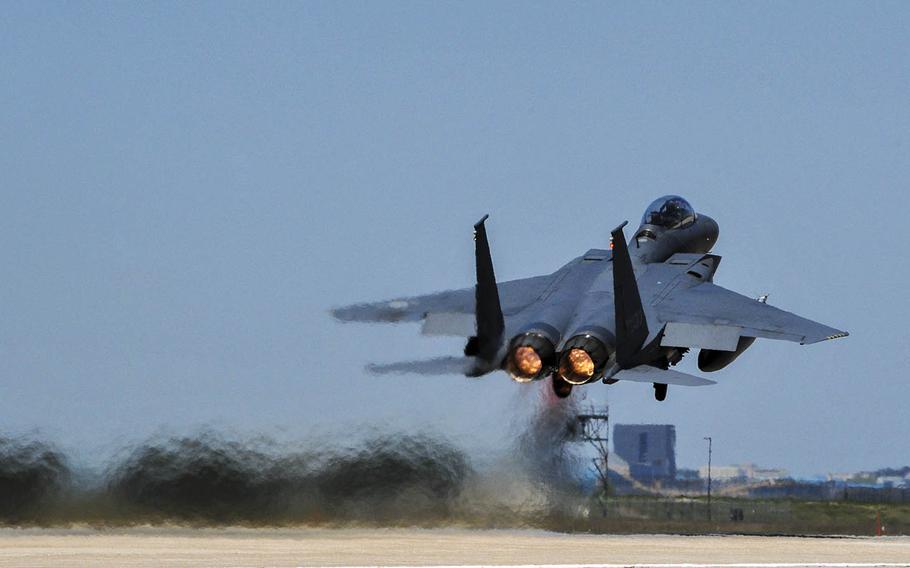
A South Korean F-15K Slam Eagle takes off from Kunsan Air Base, South Korea, April 27, 2017. (Colville McFee/U.S. Air Force)
SEOUL, South Korea — South Korean fighter jets fired some 360 warning shots after a Russian military aircraft violated airspace twice Tuesday off the peninsula’s east coast in an unprecedented breach, defense officials said.
Russia’s Defense Ministry said it had carried out a joint air patrol with China in the Asia-Pacific region for the first time. But it denied that any border violations took place.
The encounters occurred after three Russian and two Chinese warplanes entered South Korea’s air defense identification zone, which is a buffer zone that’s not defined by international law or treaty, the officials said.
A Russian early warning and control plane then advanced and briefly flew over the easternmost islets of Dokdo, which South Korea considered a violation of its territorial airspace.
Seoul mobilized fighter jets, including F-15s and F-16s, which fired warning shots to block the Russian aircraft. Officials told reporters those included flares and machine-gun rounds that were fired toward an area more than half a mile ahead of the Russian plane.
The Russian plane left the airspace after three minutes but returned about 15 minutes later, according to a timeline provided by officials from the Joint Chief of Staffs and the Ministry of National Defense.
The Russian aircraft finally left the airspace and flew out of the air defense identification zone after South Korean fighter jets responded again.
“This is the first time military planes from a foreign country violated our territorial sky,” officials said, speaking on condition of anonymity according to department policy.
South Korea’s Foreign Ministry summoned Russia’s acting ambassador, while the military summoned Russia’s defense attache to file a formal complaint with them.
Russia’s Defense Ministry said it had joined China in conducting “the first joint air patrol by long-range aircraft in the Asia-Pacific region,” according to the Tass news agency.
The ministry insisted that the flights were part of a military cooperation plan and not directed against third countries.
It also dismissed reports of warning shots against the bombers, claiming “this would have triggered an immediate response.” However, the statement didn’t refer to an A-50 reconnaissance plane, which is what the South Koreans said entered their territory.
The ministry earlier accused two South Korean F-16s of conducting unprofessional maneuvers and jeopardizing the safety of the Russian crews.
President Moon Jae-in’s national security adviser, Chung Eui-yong, warned Moscow that South Korea takes the intrusion very seriously and “will take much stronger measures” if it happens again.
Foreign planes have intruded into the air defense identification zone, known as KADIZ, but Seoul said it was the first time Chinese and Russian military planes conducted what appeared to be a joint operation.
The Russian planes that trespassed in the KADIZ included two TU-95 bombers as well as the reconnaissance aircraft. The Chinese planes were both H-6 bombers and stayed in the area for the same amount of time, according to the South Korean military.
The South Korean fighters sent more than 30 radio messages trying to communicate with the Russian and Chinese aircraft but received no reply, officials said.
The former Soviet Union was a major benefactor of the communist North. A Soviet fighter jet fired a missile at a South Korean passenger plane that had strayed into Soviet territory, killing the 269 people on board in 1983.
As South Korea’s economy improved, so did its relations with Moscow. The two countries established diplomatic ties in 1990.
gamel.kim@stripes.com Twitter: @kimgamel